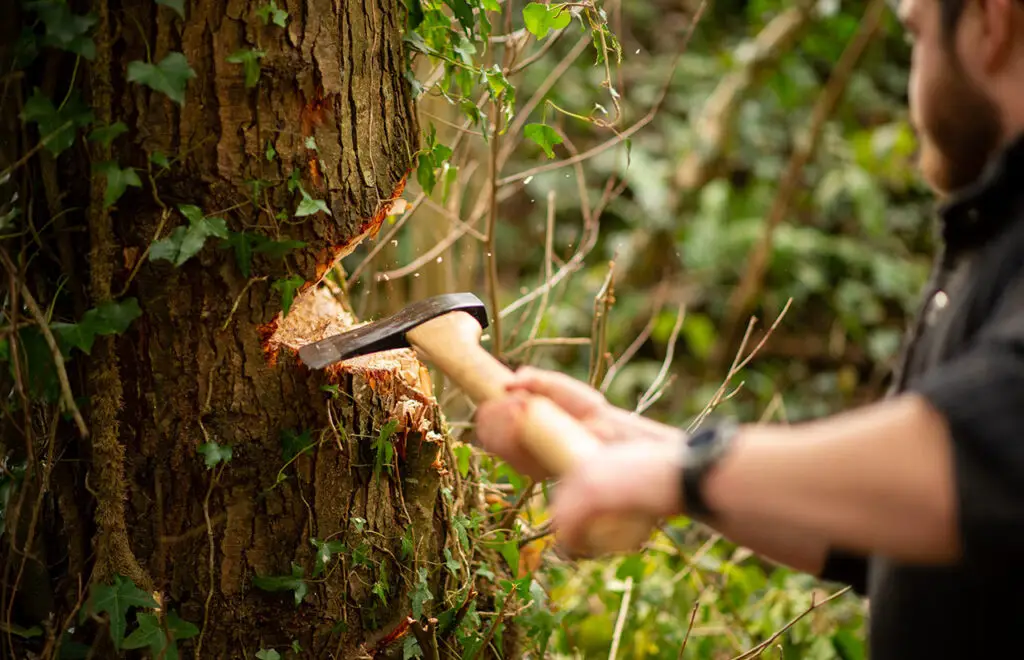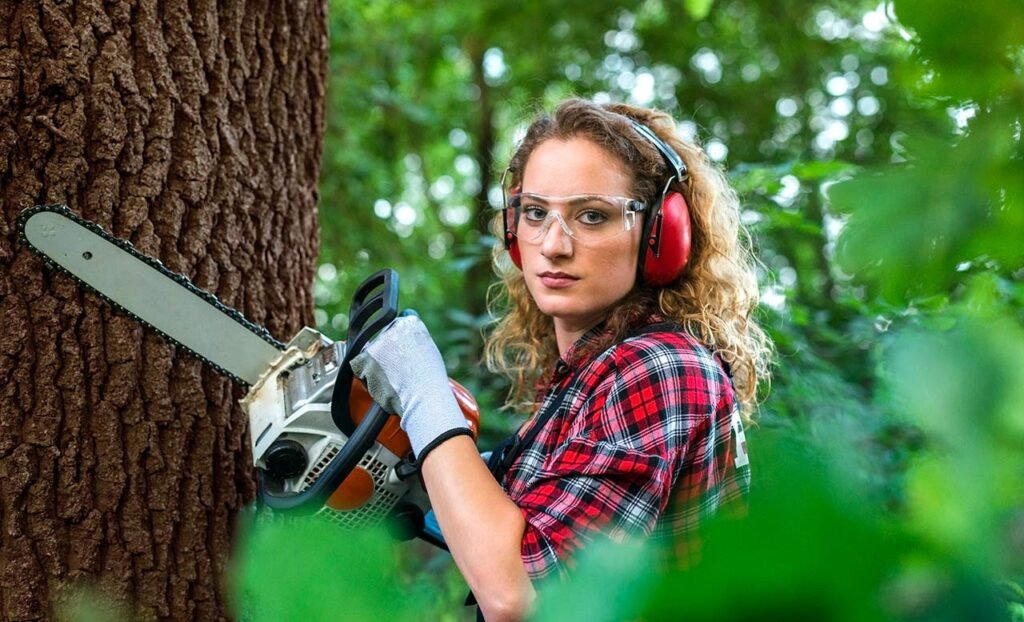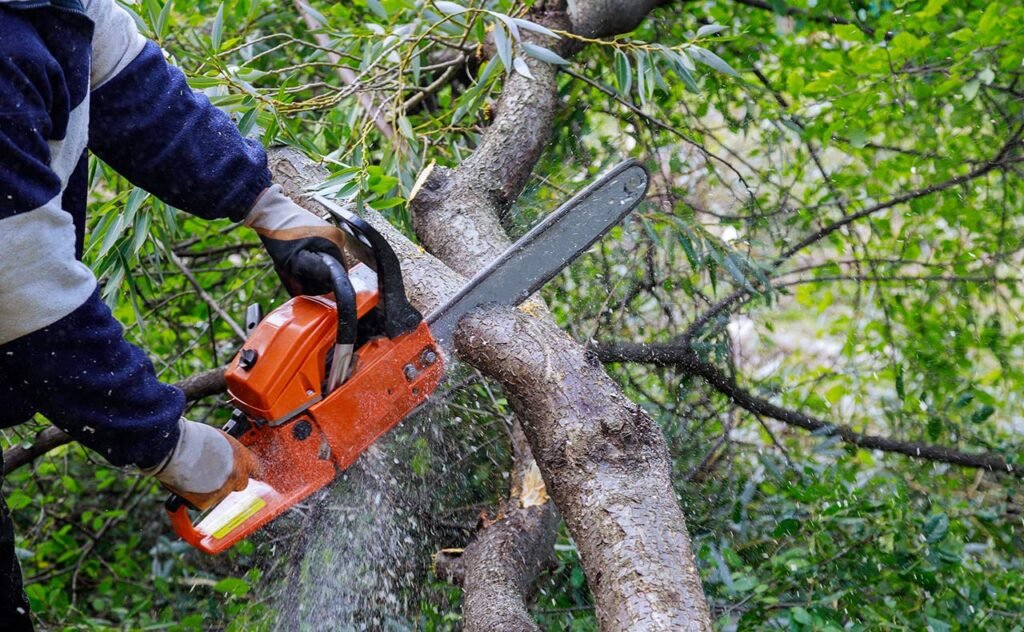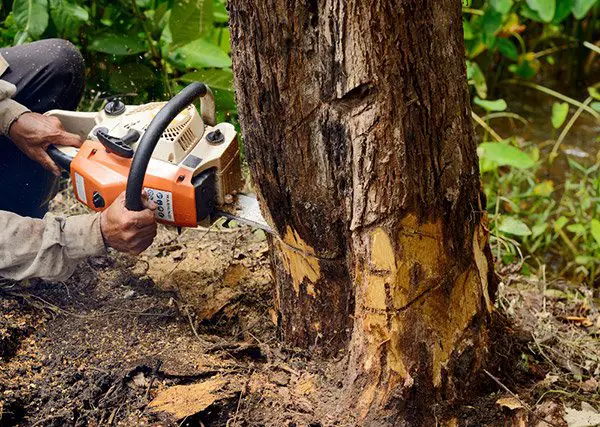How To Fell A Leaning Tree
Felling any type of tree can be a dangerous business.
If the tree you’re looking to cut down is already leaning in one direction, that can make things even more challenging.
When it comes to cutting down large and small trees, safety is the most important thing.
Here’s the two ways of cutting down a leaning tree:
- Cutting With the Lean — You’ll use specialized cuts with your saw to ensure that the tree falls in the proper direction and there is not any dangerous breakage.
- Cutting Away from the Lean — You’ll insert wedges into the tree as you perform a series of smaller cuts in order to correct the lean.
Let’s take a closer look at felling these two types of trees and how you can get this job done quickly and safely.

Getting the Tree to Fall Where You Want (And Not Where You Don’t!)
Even the largest, oldest, and most crooked trees can be safely brought down.
Leaning trees often want to fall in the direction of their lean.
This might be a good thing, or it might send that old oak right into your garage.
To cut down a leaning tree, you’ll need to do the following:
- Remove heavy branches
- Uses felling wedges to correct the lean
- Contact an arborist for professional support
Now, let’s take a look at felling a tree in the direction of the lean.
Felling a Tree With the Lean
If it seems like felling a tree in the direction of its lean is a much easier job, it’s because it is.
There are still a few things we need to keep in mind as well as a few basic steps to take in order to cut down a tree in the direction it is leaning.
The only tools you’ll need for this job is your trusty chainsaw.
You also might want to use a ladder and some rope to remove any heavy branches just to make the job a little bit safer and easier.
Check out this video for a demonstration of cutting a notch, a plunging cut, and felling a large tree.
Make a Notch in Your Tree
The first step is to put a notch in the tree on the side it’s leaning.
This will ensure that it falls in that direction.
The notch should be no more than ⅕ the width of the tree.
The notch should also be knee height or lower.
The leaning side of the tree is the hardest to cut a notch into because if it’s awkward shape.
Make sure to take your time to get this cut right and get it done safely.
- Cut the notch into the ground facing—that’s the leaning side—of the tree.
- Cut your notch no deeper than one fifth of the tree’s width.
- Cut the notch knee height or lower.
Make Plunging Cuts
Your plunging cut, also known as a bore cut, is the key to getting a leaning tree down safely.
You want to cut starting on one side just behind and slightly above the hinge of the notch you cut in earlier.
Start your bore cut on one side, and then move to the other to complete it.
This should leave you with the hinge of the notch and a small strap of wood still connecting the tree to the stump.
- Perform your plunging cut just behind the hinge of the notch you just cut.
- Start on one side and then finish the plunging cut on the other.
- You should be left with the hinge of the notch and a small strap of wood on the opposite side of your tree still connecting the trunk to the stump.
Do not cut corners when making her plunging cuts.
Even though a leaning tree is inclined to fall in the direction you want it to, kick back can be deadly if the plunging cut is not successfully completed.
Make the Felling Cut
The felling cut will be made by cutting through the strap of wood on the opposite side of the tree as the notch we cut in the first step.
After you cut through the strap, there should only be about 10% of the width of the tree still connecting the trunk to the stump.
This will snap as the tree falls towards the notch.
By completing the boring cut and then making the felling cut by removing the strap of wood opposite the notch, we are eliminating the risk of any dangerous kick back or breakage as the tree falls.
- Cut through the strap of wood opposite the notch.
- Make sure that any assistants, family members, or anyone else in the area is clear of the area the tree is expected to fall in.
- Safely going through all these steps will allow the tree to come to the ground without incident.
Felling a Tree Against the Lean

This is a less common job, but one you can still do on your own.
You’re going to need a few tools to get this job done.
- Chainsaw
- Ladder
- Rope
- Felling Wedges
- Sledge Hammer
Removing Branches
Trees typically grow branches more heavily in the direction they are leaning.
In order to remove some of this weight and get the tree to fall in a different direction, we’re going to have to cut off these branches.
You’ll use the rope to secure your ladder to the tree as well as to pull your chainsaw up to you.
It’s much safer to use the rope to lift a chainsaw up to you than it is to attempt to climb with a chainsaw.
- Raise your letter to your desired height and secure it to the tree.
- Tie the rope to your chainsaw and pull it up to you.
- Safely begin removing branches from the tree.
Removing branches makes felling the trees against the direction of the lean a much safer process.
Notching the Tree
Cut the notch on the side of the tree you want to fall towards the ground.
To begin this cut, make a flat cut about 1/4 of the way into the tree.
Then make an angular cut down towards the flat cut you just made.
When finished, the notch should be a right angle that is taken out of the tree.
Notches should be cut at a comfortable highlight that is typically somewhere around knee height.
- Cut you were not sure about 1/4 of the way through the tree.
- Remember that notches should be cut about knee height.
Start Your Felling Cut
Here’s where things get a little more complicated.
You’re going to want to start your felling cut with your chainsaw on the opposite side of your notch.
Cut about one-third of the way into the tree and leave your chainsaw bar in the tree and running.
Make sure to turn on your chainsaw safety so that it does not begin cutting by accident.
- Begin your felling cut on the opposite side of the notch.
- Cut about one-third of the way into the tree.
Drive the Wedges In
Next, drive your felling wedges into the cut you just created.
Felling wedges and shims should be used at this point to stand the tree upright.
If the tree cannot be straightened by using felling wedges at this stage, it is unsafe to finish this cut.
If the tree is still crooked after inserting felling wedges, you need to call a professional arborist and have them safely take the tree down for you.
- Drive your felling wedges into the cut you just created to straighten your tree.
- If the tree does not straighten, you need to have a professional arborist finish this job.
- Remember to leave your chainsaw bar in the tree during this stage as this will allow you to complete the cut later.
Finish Your Felling Cut
After you drive in your wedges, and only if the tree is now standing up straight, you can resume your felling cut.
Disengage your chainsaw safety and begin cutting towards the notch.
As your chainsaw’s bar approaches the notch, the tree will fall in the direction you have notched.
- Disengage the chainsaw safety.
- Resume cutting towards the notch.
- Stay alert at all times as leaning trees can fall in unexpected ways.
- Always have to clear paths of exit.
- Make sure that everyone else is out of the range of the falling tree.
Leaning trees are often old, damaged, or rotting.
This means that they can fall in unexpected ways.
This is especially the case if you’re feeling a leaning tree against the direction of the lean.
Remember, safety is the first step in felling a tree.
Tips for Felling Small Trees

Trees that are less than 10 inches in diameter are just too small to fill with any of the previous methods we have mentioned above.
Here are some steps that you can take to fill a smaller tree against the direction of the lean.
Make a Cut for Your Wedges
Your first cut should be designed to accommodate your wedges.
Unlike with our previous examples, we’re going to insert our wedges and straighten this tree before cutting our notch.
Drive Your Wedges into the Tree
Next you’ll drive your wedges into the tree.
This time we will be removing our chainsaw from the tree before driving our wedges in.
Your goal is to straighten the tree here.
Again, if the tree does not straighten it is not safe to cut without an arborist.
Cut a Notch
After the tree has been straightened, cut a notch into the opposite side of where you made your first cut.
Remember, the tree will be falling in the direction of the notch so plan ahead.
This notch should be no more than 1/4 of the width of the tree.
Fell the Tree Using Wedges
Now it’s time to fell the tree using wedges.
Drive your wedges in with a sledgehammer, and they will begin to push you a tree over.
If you made your first cut deep enough, driving in the wedges alone should be more than enough to bring the tree to the ground.
Can You Fell a Tree With a Chainsaw?
Yes. Here’s how you can fell a leaning tree with a chainsaw.

- Remove as many large branches as you can from the tree to lower its center of gravity and reduce its weight.
- Cut a notch into the tree on the side you want the tree to fall on.
- Begin your felling cut on the opposite side of the notch.
- Drive wedges into the felling cut you have made and hammer them in until the tree stands up straight.
- Complete your felling cut with your chainsaw.
Remember, if your tree fails to stand up straight you should have a professional arborist finish this job for you.